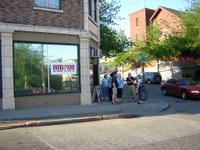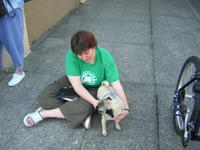Sabbatical visits:
Three Nails, Pittsburgh, PA
What was your first impression as you entered?
Three Nails is not organized around a central gathering and location, like nearly all other congregations. Rather Three Nails is a collection of many small groups with a common leadership group and common values. So even though they do gather together for worship, the worship gathering was not my first impression. My first impression was of their small groups. Since the small groups are not “one of the programs of the church,” but are the church, this report will include both the small group and the worship experience.
How long was the service?
1) Small group: 2 hours
2) Worship: about an hour and a half
How was the service structured?
1) The small group had two parts: the community building and the study, each lasting about an hour. The particular group I visited happens to gather on Sunday morning at one of the group member’s homes, but the groups vary. At this particular gathering, group members brought Bibles and ingredients for omelets. The Bibles were set aside for later use, while the group gathered in the kitchen to make breakfast and engage in lively conversation. It was clear that this was a group of friends who enjoyed one another. After an hour it turned to a fascinating discussion launched from a chapter of Lewis’ Screwtape Letters (which they are reading together). They integrated the readings with related Scripture and their daily life experience.
2) The worship service was Holy Eucharist, Rite II.
What did you like best?
The tangible experience of an intimate community of people who are very intentionally and consciously focused on following Jesus together. This was evident in the small group discussion. I don't recall experiencing any other group of people who sounded more open, more honest, more caring, and more empathic toward one another’s serious wrestling about how to follow Jesus in their current lives. This was both refreshing, exciting and spiritually challenging to experience.
What did you dislike?
They are so focused on their community that there is an invisible barrier between their community and the world around them. It was enormously difficult just to find them, as gathering times and locations are known only to the membership -- and fluid. An outside cannot just drop in without an invitation. (It took me a number of emails and phone calls. Ask me to tell you the story about finding the address for worship!) Unless one has a prior relationship with one of the members, it is very unlikely that anyone would cross all the hurdles in seeking them out. Although individually they expressed interest in mission, as in “we’re happy to do something for you,” they appeared reluctant about opening their doors to the world.
What were its greatest strengths that you’d like to import?
Their small group leaders have both skill and commitment. I'd love to import their leaders!
If you were looking for a church, would this be it?
If one were a friend of one of the members, one might find the experience of intimate community and intentional discipleship to be very appealing. But if one were not already friends with one of the members, it is doubtful that one would ever find Three Nails. Honestly, I felt like I was crashing a private party. It was a great party among great friends, but it is hard to imagine that an outsider would return.
What did you learn from this visit?
This experience has challenged me to consider again whether there is an inverse relationship between intentional community and an inviting accessibility to the stranger. I am increasingly convinced that the appearance of such an inverse relationship is the result of our neglect and inattention. I am increasingly convinced that we impoverish ourselves by neglecting small groups and deep, Christian community (what Scripture calls “fellowship” although we use “fellowship” to describe polite chatter over finger food). Simultaneously, I am increasingly convinced that we impoverish ourselves and the world by neglecting intentional, inviting hospitality to the stranger. My experience at Three Nails taught me that I really must move both of these higher up the priority list.
Is there anything else you want to say?
1) Three Nails is a very new church start. They’re just getting off the ground, and haven’t even decided on direction, leadership, or affiliation. But if they become serious about reaching out to the wider world, and if they solve an unfortunate leadership challenge (they lost their key leader in an accident), they could become a role model for churches everywhere in building communities of intentional disciples.
2) Once I overcame their built-in, invisible barriers to outsiders, they were very warm and gracious to me.
3) Thanks for the book!!
This is my opinion; I could be wrong.
The Lord be with you.






